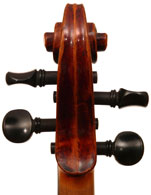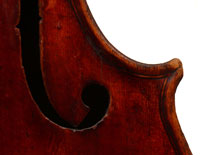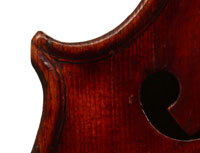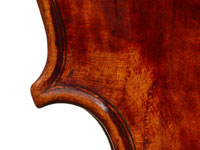Ref : 0378
A fine French violin of the
Pique School
Unlabelled
Circa 1800
Consensus by all experts who have seen this violin is that it is French. It is unlabelled and dates from around 1790 to 1810. Some debate exists around its exact origin: a leading London-based dealer and authority believes this to be the work of François Pique (1758-1822). The important Canadian violinist and pedagogue, Prof. Walter Mony, who himself at some stage used a Pique, agreed with that view. At was also at some stage thought to be an early Lupot, dating from the period when he was working in Orléans, before 1794.However, during an examination of this instrument by the important French authority, Jean-Jacques Rampal, in Paris in 2008, Mr Rampal confirmed its French origins, but felt that it would be very difficult to identify the maker. It would be safe enough to say simply that this violin is from the Pique school.
As much as that may be true, a closer examination of the f-holes would suggest that in shape and character they are closer to the work of Lupot, than to Pique. It is known that during his late-Orléans period Lupot produced several violins based on a smaller Stradivari model, all of them characterized by an extraordinary deep ruby-tinted varnish of unusual beauty and, above all, with an exceptionally attractive silvery tone with good projection. What sets this violin aside is its tonal beauty. It is an ideal instrument for quartet playing - clear, penetrative, very responsive and easy to play on, mature and with a beautiful and responsive g-string.
This instrument was rescued from total oblivion and delapidation in 2005. Structurally it is in excellent condition, with no large repairs or serious cracks evident anywhere. Two corners were damaged but have been reconstructed. An effort by someone at securing the edge and purfling around the top right bout was less successful visually, but is nevertheless secure, so it was decided to leave it as is.
When found, this violin was covered in a dark coat of cheap commercial varnish, and with the back/rib seams around the lower bouts held together with a chemical epoxy. The removal of the epoxy left inevitable superficial damage to the varnish on the ribs in the lower bouts, but with no structural damage. The original varnish on the top, ribs and scroll was exposed after careful removal of the later varnish. Furthermore, an earlier attempt by someone unknown to strip the back has left the original varnish largely compromised and the back scratched, but not structurally damaged.
What strikes one in this violin is the original ruby coloured varnish of the front, which is of an exquisite color that only the French of that time could achieve and a fabulous example of its genre. The back is of one piece.
The purfling is superb and the mitres are faultless - the corners are of a craftmanship or a very high standard with fabulously executed bee-stings. More than anything it is this aspect of the violin, combined with its exceptional tonal properties, that show its origin to be by the hand of an unusually skilled maker.
 |
 |
 |
||
 |
Dimensions : Back length: 35 7 cm
Condition : Structurally very secure. No serious cracks evident. Minor cracks including two wingcracks secured correctly. Two corners rebuilt. Some recontruction of upper right bout edge on front secure, but could have been better done. Varnish on back compromised in earlier attempt to strip it off. Front and sides have been cleaned up of coat of later cheap varnish, in order to reveal original varnish. Varnish around the lower ribs have been damaged by epoxy, now removed. Button has been structurally built-up and secured. Hairline crack in the back at the button area is secured from the inside and held secure by the neck block.
Provenance : Unknown. This violin was rescued from extreme oblivion and neglect. Now the property of Johan Grobbelaar.
Price : Withheld
 |
 |
 |
 |
 |
 |
 |
 |
 |
 |
 |
 |
|||||
 |
 |
 |